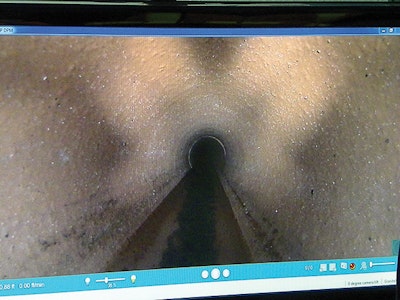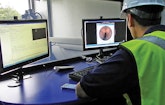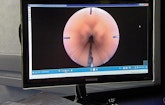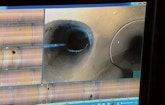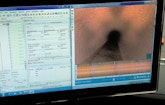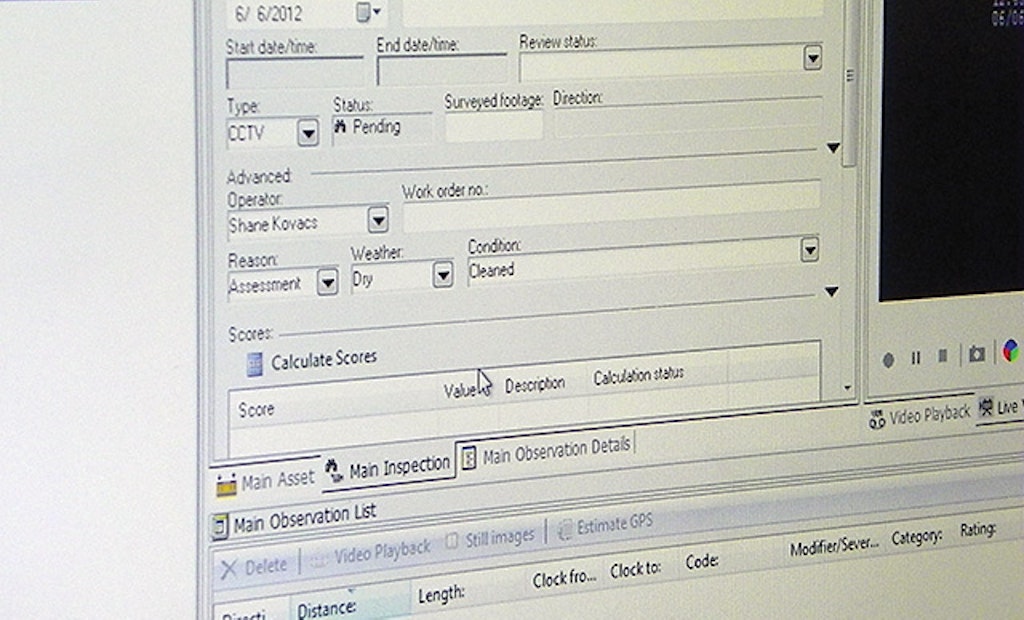Interested in Cleaning?
Get Cleaning articles, news and videos right in your inbox! Sign up now.
Cleaning + Get AlertsThe CUES semi-autonomous Digital Universal Camera (DUC) overcomes the limitations of analog CCTV by capturing high-definition images with eight times greater resolution. The resultant digitally unfolded images can be manipulated, cataloged and evaluated up to six times faster than analog images using CUES' proprietary Granite XP Asset Management Software. The DUC can be mounted to most CUES transporters as well as many manufactured by others. Likewise, other manufacturers' digital image management software can also be used.
CUES vice president of sales Paul Stenzler, technical support specialist Ryan Haughton, and system demonstrator Shane Kovacs demonstrated the DUC and its supporting Granite XP software in an 8-inch vitrified clay pipe serving a residential neighborhood in Orlando, Fla. Several members of the utilities maintenance staff of the Orange County Utilities Commission's Water Reclamation Division also viewed the demonstration.
Walk-around
A cylindrical body houses and protects the DUC high-definition camera and an adjustable output LED lighting system. Weighing about 9 1/2 pounds and with no moving parts, the forward end of the camera looks and performs like a bulbous fish-eye lens that has a 185-degree field of view.
The camera body is 3 inches in diameter; the forward portion where the lens is housed is 4 1/2 inches in diameter.
Forward-focused LED lamps alternate with a second LED array, both of which are wrapped around the lens. The LEDs' intensity is operator variable; the Granite XP software further enables the operator to select from a variety of preset illumination intensities matched for pipe diameter and material. The LEDs and lens are protected behind an additional clear lens. Portions of this lens are frosted to diffuse some of the LEDs' output, while other portions are clear to enable collimated (focused) illumination down the pipe for a distance of several pipe segments.
Four metal projections around the lens' perimeter extend forward, providing protection that diminishes the likelihood of debris strikes.
The camera has no shutter, yet it captures four "still images" per second. This is achieved by the precisely timed strobing of the LEDs. In a pitch-black pipe, each flash is captured as a discrete, manipulatable image.
The body is about 14 inches long. On the rear surface, there is a single, armored, waterproof connector for the control and video cable's attachment. This connection delivers the digital video feed to the Granite XP software.
Tractor and tractor tire selection enable inspection of pipes from 6 to 60 inches in diameter. Positioning the camera's centerline of travel in the subject pipe's centerline optimizes the quality of the resultant images. Steerable transporters are recommended for pipes with a diameter greater than 18 inches.
The Granite XP software manipulates each still image. The images of the view through a continuous pipe are unwrapped, uncoiled or "flattened." Next, they are seamlessly stitched together into a "multi-flat view." Several multi-flats are then stitched together to create an "extended flat." The Granite XP software also creates a digital "movie" of the traverse, which can be further manipulated.
The time needed for condition assessment and recording is compressed by the evaluator's ability to instantly jump from defect to defect in lieu of watching foot after foot of satisfactory pipe pass by on screen.
Operation
The DUC was mounted to the transporter, in this case a CUES steerable Pipe Ranger. This model was selected to position the camera in the pipe's centerline. The camera is secured with a pair of hand-operated clamps; the cable is secured with a press-and-twist connector.
The unit was run through a lights check. On the surface, when strobing, the individual flashes are not detectable by the human eye; they appear to shine continuously. The transporter control system was also checked on the residential street. The unit was introduced into the manhole using the standard CUES lowering hook method. The cable was routed through an anti-chafing device as it entered the mainline and through a pulley at the manhole lip. These measures assure the cable's free movement through these potential pinch-points and add an extra level of protection for the cable's exterior surface.
In the inspection truck's operations cab, Haughton was loading manhole identification information, pipe characteristics, GPS coding and related information into the Granite XP software. Then Kovacs, a PACP certified evaluator, took over. He initiated the tractor's forward movement and observed the video feed as it was received. After verifying image quality, camera orientation and proper tractor response, the traverse was initiated and image capture began immediately.
On screen, the images were displayed in three "panes." The traditional real-time, forward-looking view is in the largest pane on the right portion of the monitor. As the traverse continued, the stitched segments displayed, segment-by-segment, down the left side pane. A similar, but longer stitched image spread across the monitor's bottom pane. As the transporter advanced, the images moved across the pane, keeping pace with the transporter's progress through the pipe.
By looking at the different panes, the operator could see what the camera was encountering. He could see a panoramic view of the preceding 50 feet of pipe in the bottom pane, and to the left, a column of multi-flat stitched segments.
The entire traverse and data capture was accomplished with the tractor operating on cruise control and required no operator intervention. When the next manhole in the line was encountered, the operator could choose retrieval or continuing the traverse through to the next manhole. Flow-path alignment and cable length are the limiting factors for this decision. Retrieval was selected and initiated. The transporter was retrieved at about 50 feet per minute.
All of the basic segment information, images, digital video and stitched segments were saved to onboard hard drives as they occurred. At the end of a work shift , all of the stored data is delivered to the utility or contractor's central office where the actual condition assessment takes place. With sufficient bandwidth and coverage, the report can be emailed to an organization's headquarters while the inspection vehicle is traveling to the next manhole access.
Kovacs demonstrated the Granite XP software in the inspection vehicle following transporter retrieval. This is the same process that usually is performed in a central office by a dedicated evaluation team.
After loading the inspection file into the software, images were again displayed in three panes. First, his eye scanned the bottom extended flat pane as he looked for signs of defects. When a suspected defect was observed, he mouse clicked directly on the defect. This immediately presented a forward-looking view of the suspect spot on the main viewing pane. There he could "virtually" pan, tilt and zoom the view as well as "move" the tractor forward or backward. In a like manner, he could mouse click on a lateral junction. The virtual forward movement was stopped as Kovacs panned, tilted and zoomed the image to look into the conjoined pipe. In this mode, a software tool enables defects' dimensions to be measured and noted as part of the record for the precise point where they were taken.
Kovacs opened a database pane into which he recorded condition assessment notations and previously obtained measurements. These tasks are supported and enabled by the Granite XP software, which allows a host of preset comments to be stored, selected and entered by mouse click rather than keyboarding. The uniformity of data notation assures consistency of notes and eliminates subjective labeling. The Granite XP software can present the defect report in a variety of industry-standard tabular and database formats that can be saved electronically or printed.
Observer's comments
Two of the three traditional inspection components — lights and camera — are combined into a single unit, the DUC. This enables owners of prior generation or legacy transporters and image capture systems to immediately transition into digital CCTV inspection with limited secondary costs.
The DUC requires complementary software for image manipulation and condition assessment reporting and data management. An appropriately sized and controlled transporter is needed to carry it through the pipes. Because of the more rigorous demands of digital image manipulation, more than a basic laptop computer will be needed.
Essential operator skills may be redefined and limited to unit configuration, connection, introduction and retrieval, and basic operation validation. Asset owners can conduct inspection assessments in their own office the following day, although when faced with an urgent need for condition assessment, that process could begin even while the transporter is being retrieved.
The DUC brings asset owners a variety of deployment and information management options.
Manufacturer's comments
CUES vice president of sales Paul Stenzler noted that "the DUC, with eight times greater picture resolution, is a new generation of high-definition video inspection camera; it is a major departure from the traditional analog technology.
"Typically, the digital data is recorded in a single uninterrupted pass without operator-directed stop and look, pan and tilt actions. This continuous data gathering process can increase productivity by a factor of five."
Stenzler says analysis of high-quality images results in fewer condition assessment errors like missed or mismeasured defects. "Offsets and sags are easily recognized after the images have been unfolded and are presented, flattened on screen. Analysis advances from defect to defect by mouse click. Defect-free sections are bypassed instantly.
"The DUC can be mounted on most CUES Legacy transporters, making the transition from analog to digital data an appealing opportunity to increase accuracy and productivity while lowering operation costs."
